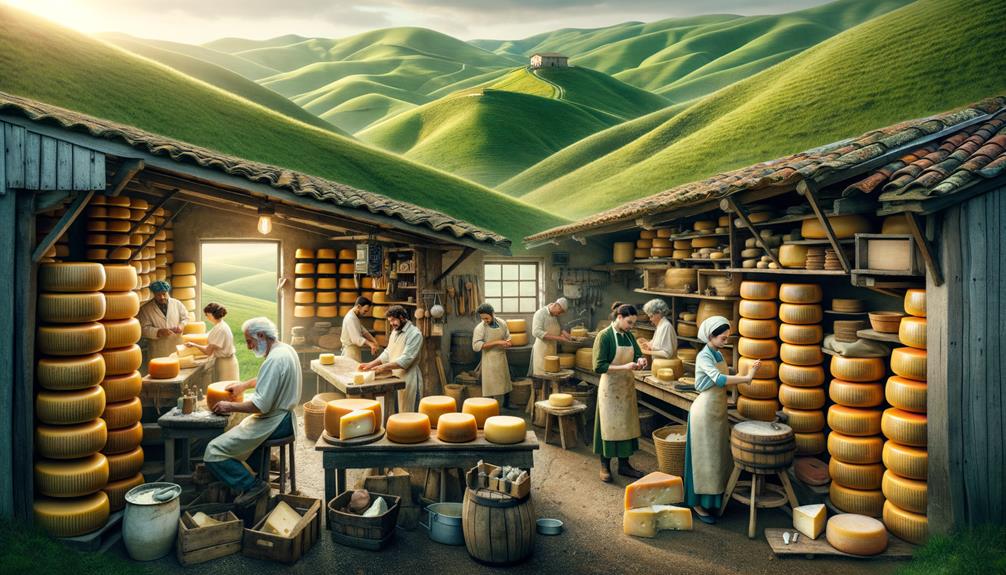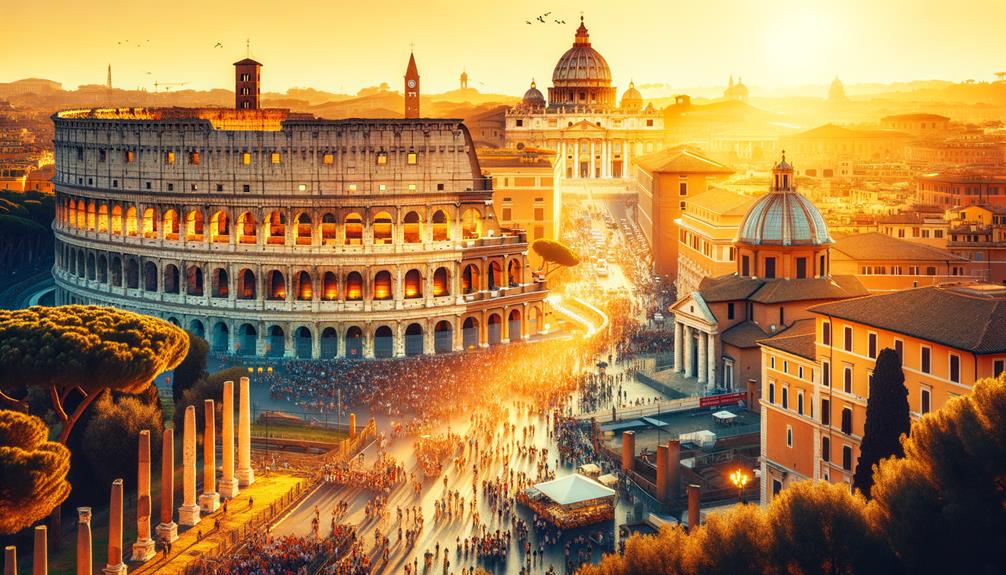While wandering through Reggio Emilia, I found myself drawn to the rich aromas of Parmigiano-Reggiano at Caseificio San Bernardino. Picture this: local artisans meticulously stirring vats of milk, each movement a part of a well-rehearsed routine. I couldn't resist sampling the freshly cut cheese, its nutty flavor a testament to their craftsmanship. But the highlight of my day was an unexpected stop at Mercato Albinelli, where the local charm and delicious foods left me both satisfied and eager for more.
The Origins of Parmigiano-Reggiano
Diving into the rich history of Parmigiano-Reggiano, we find ourselves in the heart of Reggio Emilia, where the cheese's thousand-year-old tradition began with just milk, salt, and rennet. It's fascinating to think that Parmigiano Reggiano, or what many outside Italy know as Parmesan cheese, has been crafted in this region for centuries. The simplicity of its ingredients belies the complexity of its flavor—a tribute to the artistry of the local dairies.
Reggio Emilia isn't just a place; it's a living museum of dairy craftsmanship. Imagine the medieval monks who first concocted this golden delight, stirring vast cauldrons of milk, salt, and rennet, creating wheels of cheese that would grow richer with age. Every wheel of Parmigiano Reggiano tells a story of the land, the cows, and the people who nurture this tradition.
The Parmigiano-Reggiano Cheese Consortium guarantees that each wheel meets stringent quality standards. They're the guardians of this dairy treasure, certifying that the cheese maintains its renowned reputation. And so, in Reggio Emilia, the story of Parmesan cheese is not just about eating; it's about savoring a slice of history.
Touring a Local Dairy
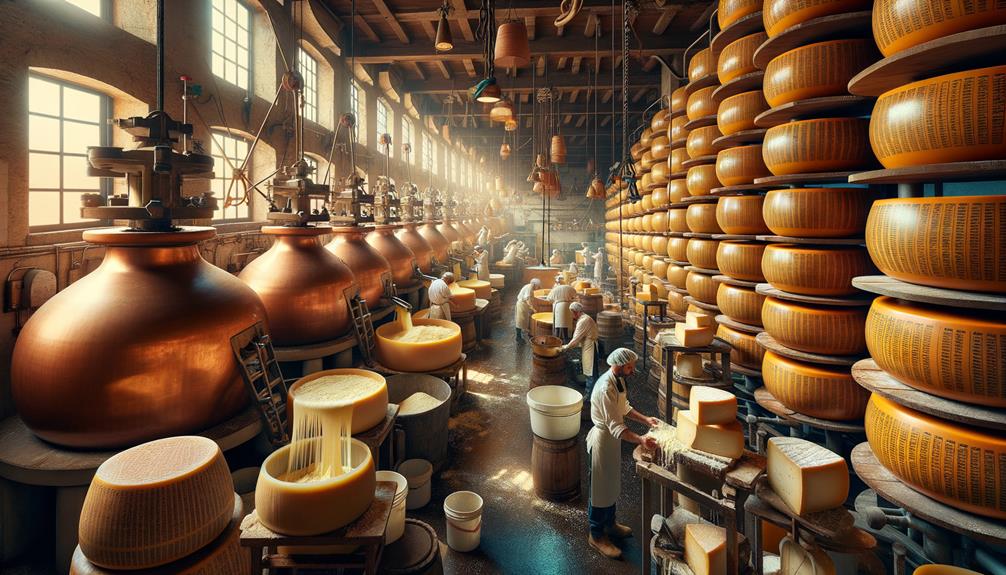
Walking into the local dairy, the rich aroma of aging Parmigiano Reggiano immediately greets me, hinting at a long-standing tradition. Watching the dairy experts carefully cook, mold, and salt the milk feels like witnessing a culinary art form. As I taste the cheese at different stages of aging, I'm amazed at how time affects its complex flavors—each sample is a testament to patience and craftsmanship.
Traditional Cheese-Making Process
When you visit a local dairy, the rich aroma of fermenting milk lets you know you're in for a treat. Witnessing the traditional process of making Parmigiano Reggiano is a captivating experience. Walking into the dairy, the blend of sights and smells immediately draws you in.
The process here is truly an art. Milk is heated in large copper vats under the careful watch of experienced dairy workers. Every step, from cooking to molding and salting, is done with incredible precision. It's like watching a maestro conduct an orchestra, where every note must be perfect to uphold the high standards of Parmigiano Reggiano.
The Parmigiano-Reggiano Cheese Consortium acts as a strict overseer, ensuring that the cheese meets all regulations. This legendary cheese can only be made in the provinces of Parma, Reggio Emilia, Modena, Bologna, and Mantua.
In our fast-paced world, seeing such tradition preserved is refreshing. Each wheel of Parmigiano Reggiano represents time, craftsmanship, and unwavering quality. It's more than just cheese; it's a cultural symbol that honors age-old practices.
Aging and Storage Techniques
As I venture deeper into the dairy, the sight of endless rows of cheese wheels aging gracefully in vast, climate-controlled rooms captures my imagination. Each wheel of Parmigiano Reggiano sits with quiet dignity, waiting for the maturation process to work its magic. The air is thick with the rich aroma of aging cheese, a testament to the meticulous care provided by the dairy experts.
These maturation rooms are the heart of the dairy, where the cheese undergoes a transformation. The process takes at least 24 months, sometimes extending to 36 months or more. Here, the dairy experts perform daily checks, ensuring each wheel meets the stringent standards set by the Parmigiano Reggiano Consortium. They use hot-iron branding to mark those that pass the rigorous inspections.
Watching this, I can't help but admire the dedication and precision involved. It's a labor of love, a dance between tradition and quality.
- Tip: Visit during the early morning to see the experts in action.
- Tip: Ask questions about the aging process; they love sharing their knowledge.
- Tip: Take in the sensory experience—sight, smell, and touch.
- Tip: Wear comfortable shoes, as the tour involves a lot of walking.
The maturation process here is both an art and a science, and it's a privilege to witness it firsthand.
Sampling Fresh Parmigiano
Stepping into the local dairy, I can't wait to try a fresh slice of Parmigiano Reggiano, a masterpiece of time-honored craftsmanship. The air is filled with the rich, nutty aroma of cheese wheels aging to perfection, each one a testament to patience and care.
As I wander through the maturation rooms, I'm amazed by the rows of Parmigiano Reggiano, each wheel resting and slowly developing its flavor. Experts routinely check each wheel to ensure it meets the high standards for the prestigious hot-iron branding. The commitment to tradition is evident, and it's easy to see why this cheese is a culinary icon.
At the tasting table, a knowledgeable guide cuts into a wheel, revealing its crystalline texture. My first bite is a revelation, bursting with nutty, salty, and slightly sweet flavors. The guide shares insights into the different maturation stages, enriching the experience with stories about the cheese's history and tips on pairing it with other local products.
Tasting fresh Parmigiano Reggiano is more than just sampling cheese; it's a journey through history and tradition, capturing the essence of Reggio Emilia.
The Cheese-Making Process
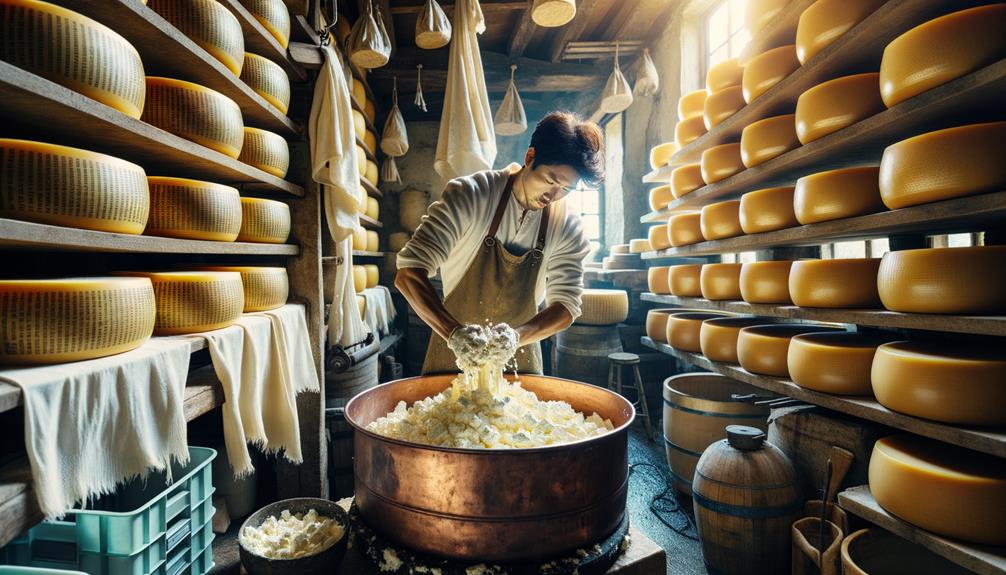
In the Reggio Emilia countryside, the art of making Parmigiano Reggiano starts with choosing the best local milk. At the Parmigiano Reggiano dairy, this milk becomes the famous Parmigiano Reggiano cheese. The dairy is bustling with experts who carefully manage the cheese-making process.
First, the milk is poured into large copper vats, where it's gently heated and stirred. Rennet is then added to create curds, which are cooked to just the right consistency. This critical step is closely monitored by members of the Consorzio del Formaggio del, ensuring each stage is done perfectly.
After cooking, the curds are shaped into wheels and placed in a brine bath for several weeks. This salting step is crucial for giving the cheese its unique flavor. After salting, the cheese wheels are moved to maturation rooms, where they are carefully aged for 24 months.
- Watch the curds form in copper vats
- Smell the rich aroma of aging cheese
- Feel the texture of perfectly brined wheels
- Observe the meticulous care in maturation rooms
This journey through the Parmigiano Reggiano dairy showcases the dedication and skill behind each wheel of this celebrated cheese.
Tasting Parmigiano-Reggiano
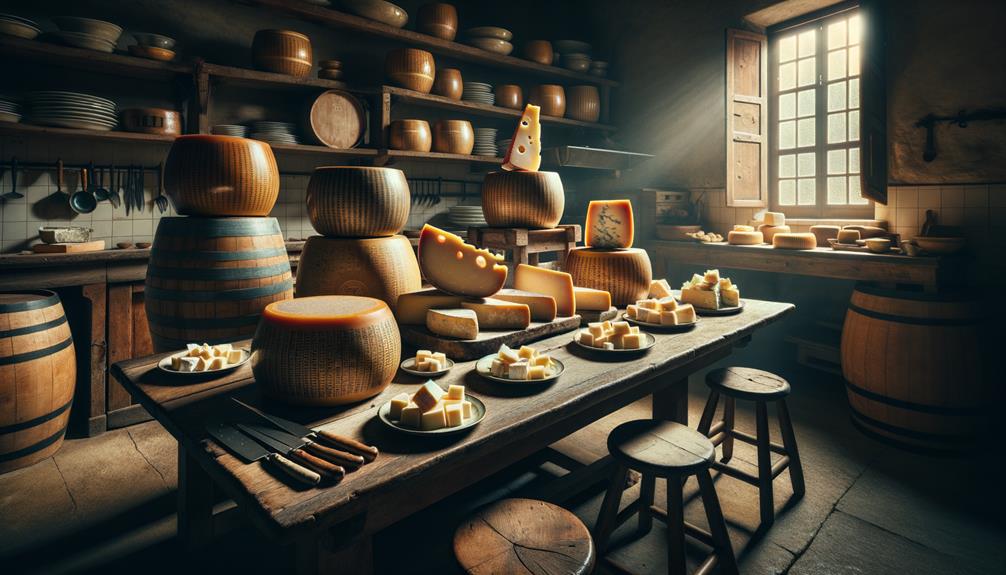
Tasting Parmigiano-Reggiano is like uncovering a rich tapestry of textures and aromas, all carefully developed over years. Each crumb of this cheese shares a tale of dedication and tradition. The dairy experts walk us through the tasting, pointing out the unique characteristics that come with different aging periods.
| Maturation Period | Flavor Profile | Texture |
|---|---|---|
| 12 months | Mild, milky, slightly tangy | Smooth, slightly firm |
| 24 months | Nutty, savory, more complex | Crumbly, crystalline |
| 36 months | Robust, bold, deep umami | Gritty, intense crunch |
Tasting the 24-month cheese, I'm amazed at how it turns nutty and savory, crumbling just right. The 36-month cheese is a flavor powerhouse, bold with deep umami, and a satisfying gritty texture.
What really strikes me is how these cheeses, made from just milk, salt, and rennet, can change so much over time. It's a testament to the high standards kept for nearly a thousand years. This tasting is more than just about cheese; it's a deep dive into the culture of Reggio Emilia.
Intermediate Stops for Local Products
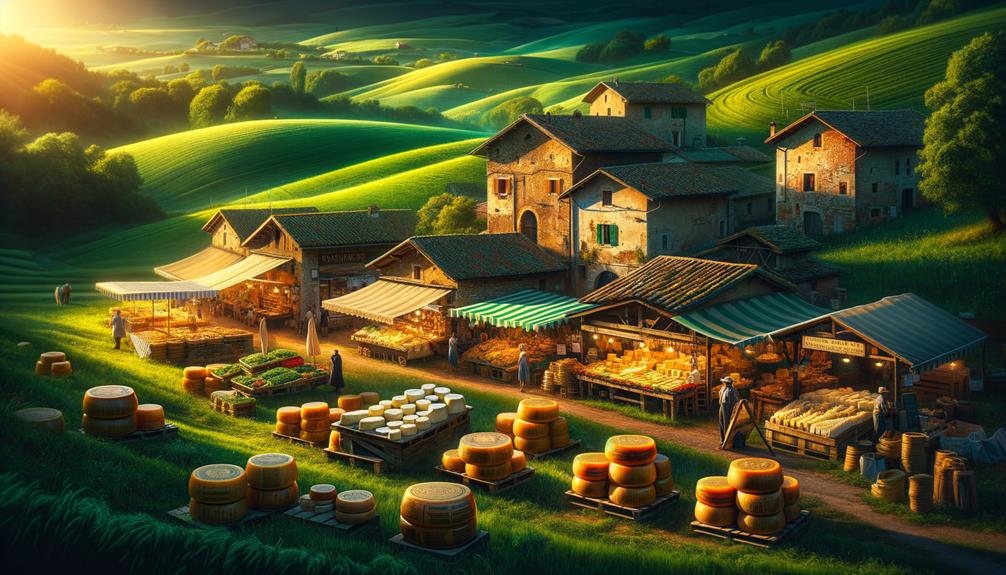
Enjoying the rich flavors of Parmigiano-Reggiano, the tour guides lead us to other culinary gems in the region, starting with a glass of sparkling Lambrusco wine. I'm excited to dive into the heart of Emilia-Romagna, where each stop promises a new taste experience.
Our first visit is to Masticabrodo, a family-run trattoria offering cooking classes on authentic Parmigiano-Reggiano dishes. I eagerly roll up my sleeves to learn the art of making Tortelli di Zucca, savoring the opportunity to create and enjoy this local specialty.
Next, we make our way to Caseificio San Bernardino, a dairy factory with the pungent aroma of aging cheese. Watching the detailed craftsmanship behind each wheel of Parmigiano-Reggiano, I develop a deeper appreciation for this iconic cheese.
At Mercato Albinelli, I immerse myself in a lively food market. Sampling Prosciutto di Parma and Balsamic Vinegar of Modena, I enjoy every bite while chatting with passionate local producers.
- Taste Lambrusco wine
- Take cooking classes at Masticabrodo
- Tour Caseificio San Bernardino
- Visit Mercato Albinelli
Each stop strengthens my connection to these exquisite local products and the culture that celebrates them.
Booking Your Tour
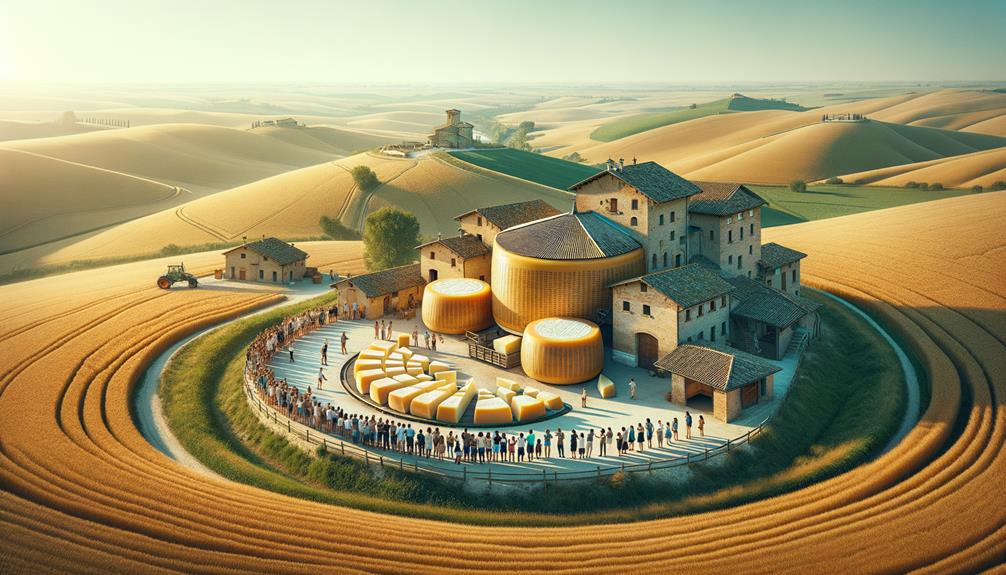
Planning your Parmigiano-Reggiano adventure is as easy as enjoying a slice of this delicious cheese. Booking your tour for the Reggio Emilia Parmigiano Experience takes just a few clicks online. The official website has all the information you need, ready to take you on a journey filled with flavor and tradition.
Entering your personal details is simple, and the site ensures your privacy. They use your information to send you helpful updates, so you'll know exactly what to expect and how to make the most of your visit. I was excited when my confirmation email arrived, packed with details about the immersive experiences ahead.
The booking system is designed to be straightforward and user-friendly. Pick your date, enter your details, and you're all set. Seeing the itinerary adds to the excitement, promising a deep dive into the world of Parmigiano-Reggiano. Trust me, the Reggio Emilia Parmigiano Experience isn't just a tour; it's a paradise for cheese lovers.
Meeting the Artisans
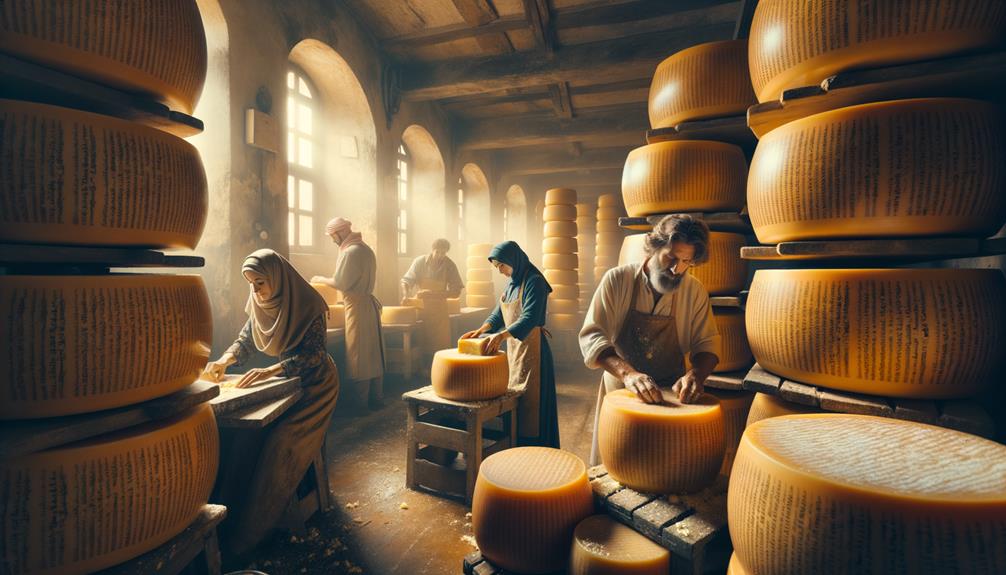
Meeting the artisans behind Parmigiano-Reggiano felt like stepping into a living museum where centuries of tradition and passion come to life. Wandering through the dairy in Parma, I was enveloped by the scent of fresh milk and aged cheese. Watching the artisans cook, mold, and salt the milk, I realized that every wheel of Parmigiano Reggiano is a tribute to their dedication. They spoke about their craft with such reverence that it felt like listening to poetry.
The maturation rooms were a sight to behold—rows upon rows of cheese wheels, each requiring daily care. The experts meticulously inspect each wheel, ensuring it meets the high standards of Parmigiano Reggiano. The process takes at least 24 months, but the end result is worth every second.
To truly appreciate this experience:
- Engage with the artisans: Their stories and knowledge are invaluable.
- Savor the tasting: Freshly cut Parmigiano Reggiano is a revelation.
- Observe the process: From cooking to branding, every step is fascinating.
- Immerse in the community: Feel the collective pride in their products and services.
Experiencing this firsthand, I felt a profound connection to the community and their timeless craft.
Supporting the Local Economy
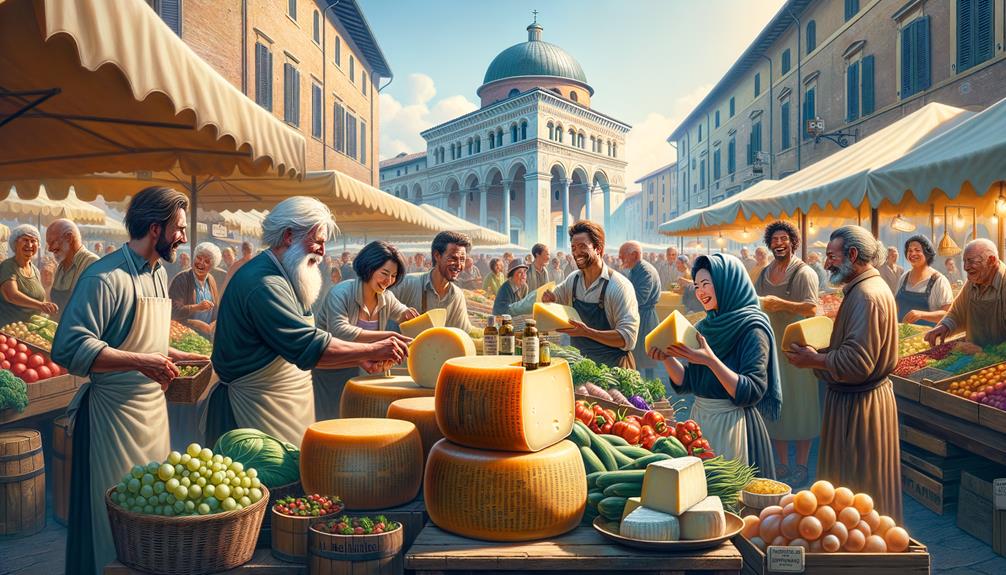
Walking through the dairy, I couldn't help but admire how buying local Parmigiano Reggiano directly supports these hardworking artisans. Each wheel of cheese represents not just a culinary treat but a tradition passed down through generations. It's incredible to see how every purchase helps maintain the region's economy and keeps these age-old practices alive.
Buying Local Products
How often do we get the chance to buy something delicious that also supports an entire community? Buying Parmigiano Reggiano in Reggio Emilia is one of those special moments. By choosing local products, we're directly helping the local economy and backing the hard-working dairy producers of Parma.
When I walk through the charming local markets, I'm not just shopping; I'm taking part in a long-standing tradition. The Parmigiano Reggiano Cheese Consortium ensures that every wheel meets strict standards, so our purchases are both genuine and top-quality. Each bite of this cheese tells a story of centuries-old techniques and the people who make it.
To fully enjoy this experience, consider these tips:
- Visit dairy farms: Meet the artisans and watch the cheese-making process up close.
- Shop at local markets: Find a variety of local products, not just cheese.
- Attend a tasting session: Learn to appreciate the different flavors of aged Parmigiano Reggiano.
- Buy directly from producers: Make sure your money goes straight to those who keep these traditions alive.
Supporting the local economy never tasted so good. Each purchase helps preserve the rural landscape and sustainable farming of Emilia-Romagna.
Promoting Artisan Craftsmanship
Connecting with the tradition of Parmigiano Reggiano making ties me to a rich history of artisans whose dedication shapes not just cheese, but the cultural life and economy of Emilia-Romagna. Stepping into a local dairy, I'm greeted by the smell of aging cheese and a sense of community. Here, craftsmanship isn't just a term; it's a way of life that keeps age-old methods alive and supports the local economy.
The Parmigiano Reggiano Cheese Consortium ensures that only cheese produced in specific regions—Parma, Reggio Emilia, Modena, Bologna, and Mantova—can carry the esteemed name. This protection honors the local artisans who have refined their skills over nearly a thousand years.
On a guided tour, I see the intricate processes handed down through generations. From stirring the curd in copper vats to the careful aging in climate-controlled rooms, every step is a testament to their dedication. By purchasing directly from these dairies, I don't just buy cheese; I support a rich community and its enduring traditions. This isn't just cheese; it's a piece of history.
Frequently Asked Questions
Where Is the Parmesan Factory in Italy?
The Parmesan factory is located in Italy's Emilia-Romagna region, covering Parma, Reggio Emilia, Modena, Bologna, and Mantua. While visiting these areas, I was amazed by the craftsmanship behind Parmigiano-Reggiano and loved tasting its famous flavors firsthand. Definitely a must-see!
What's the Difference Between Parmesan and Parmigiano?
When in Rome, do as the Romans do. Parmigiano-Reggiano is a true Italian treasure, aged for a year to develop its rich flavor. Parmesan, on the other hand, is a more general term and is often milder and less strictly regulated. Taste the difference and savor the experience!
How to Tell if Parmigiano Reggiano Is Bad?
To tell if Parmigiano Reggiano has gone bad, you can rely on your senses. Give it a sniff to check for any sour odors. Examine the rind for any signs of mold. Feel the cheese to see if it's overly hard. Taste a small piece to see if it's unusually bitter. Lastly, look for any cracks that might indicate it's past its prime. It's all about using your senses!
What Is the Difference Between Grana Padano and Parmesan Cheese?
Did you know Parmigiano Reggiano needs to age for at least 12 months? On the other hand, Grana Padano, which is milder, only requires 9 months of aging and comes from a larger region. Think of it as comparing a bold wine to a light, crisp spritzer.

